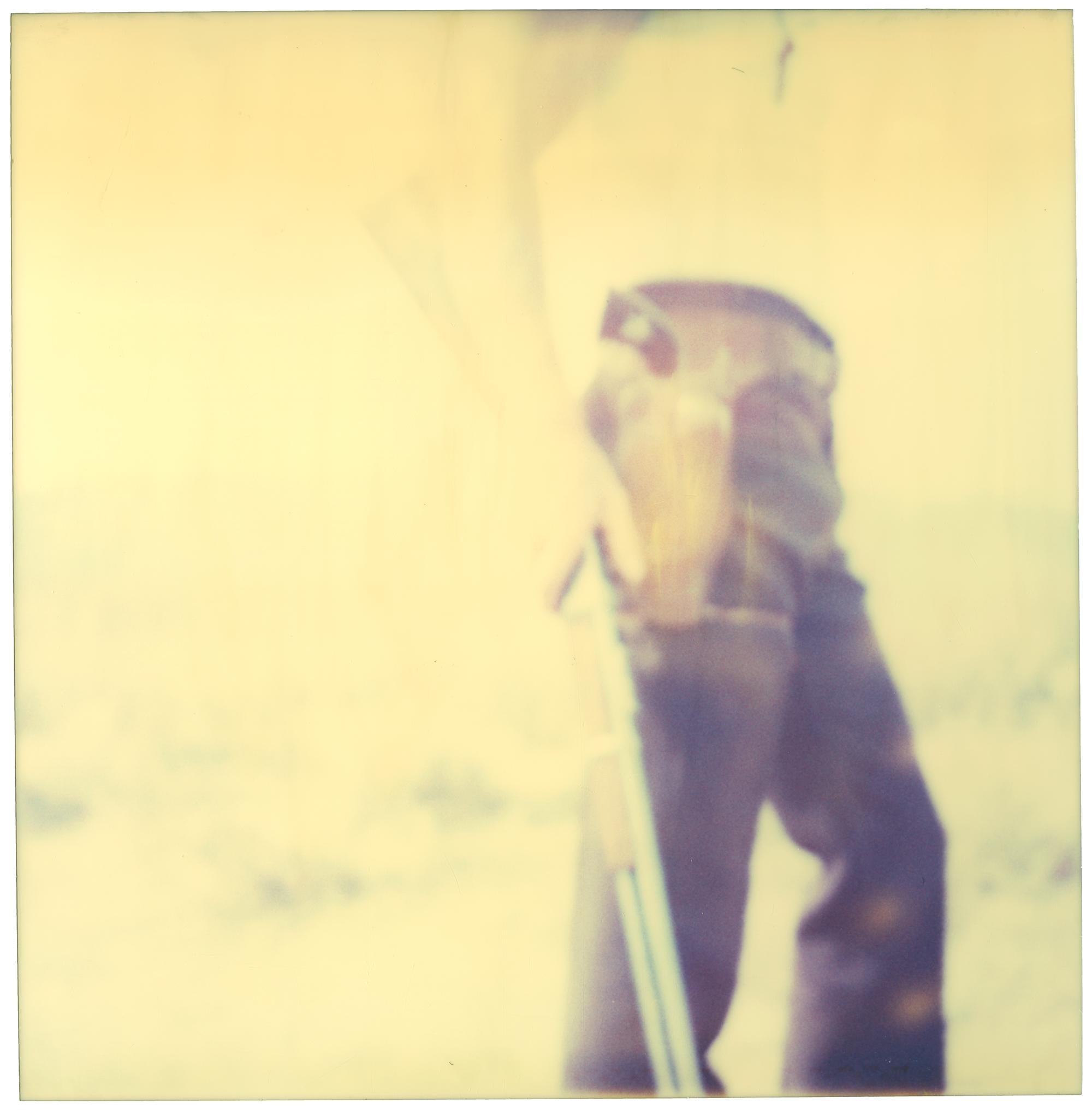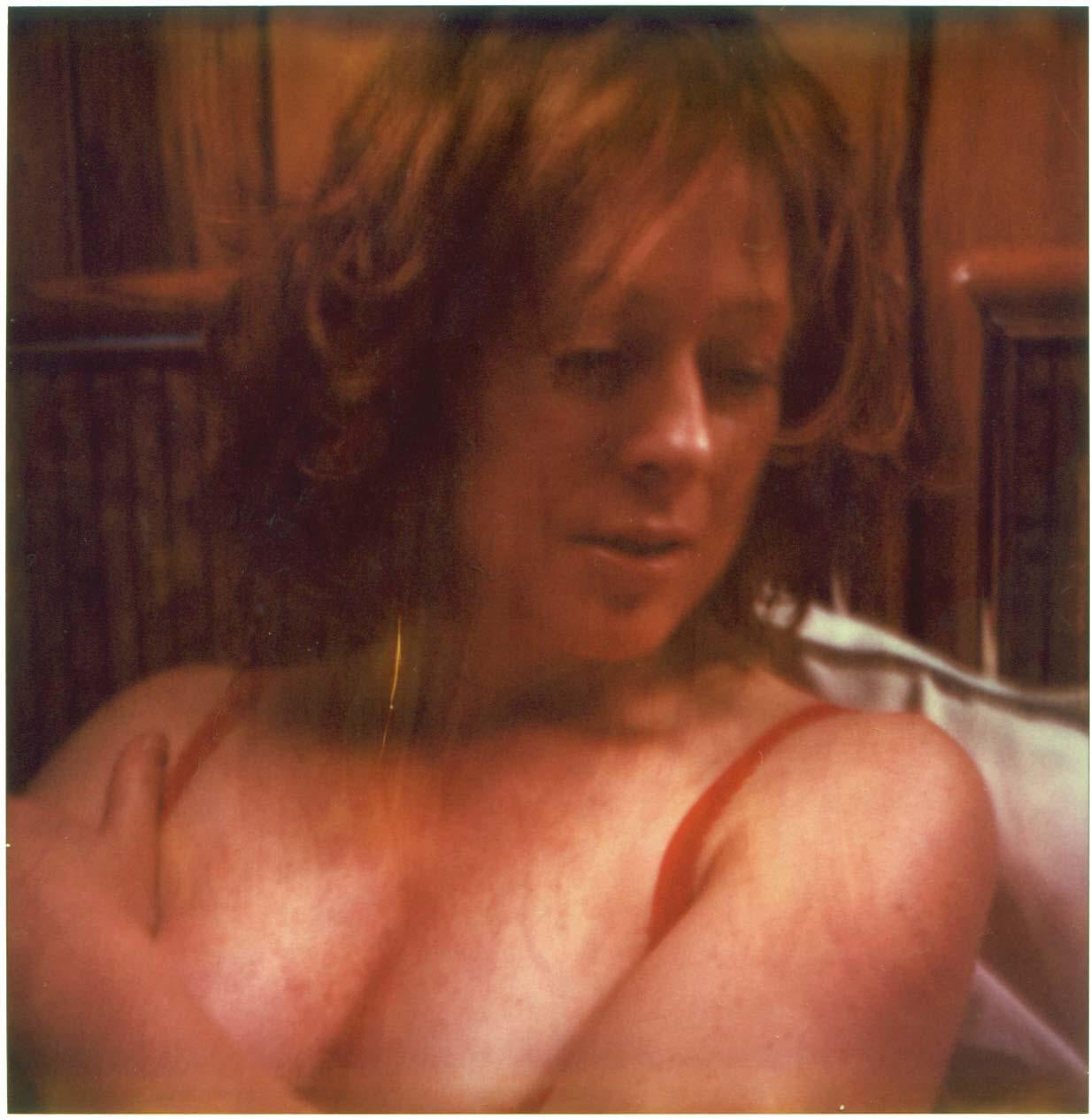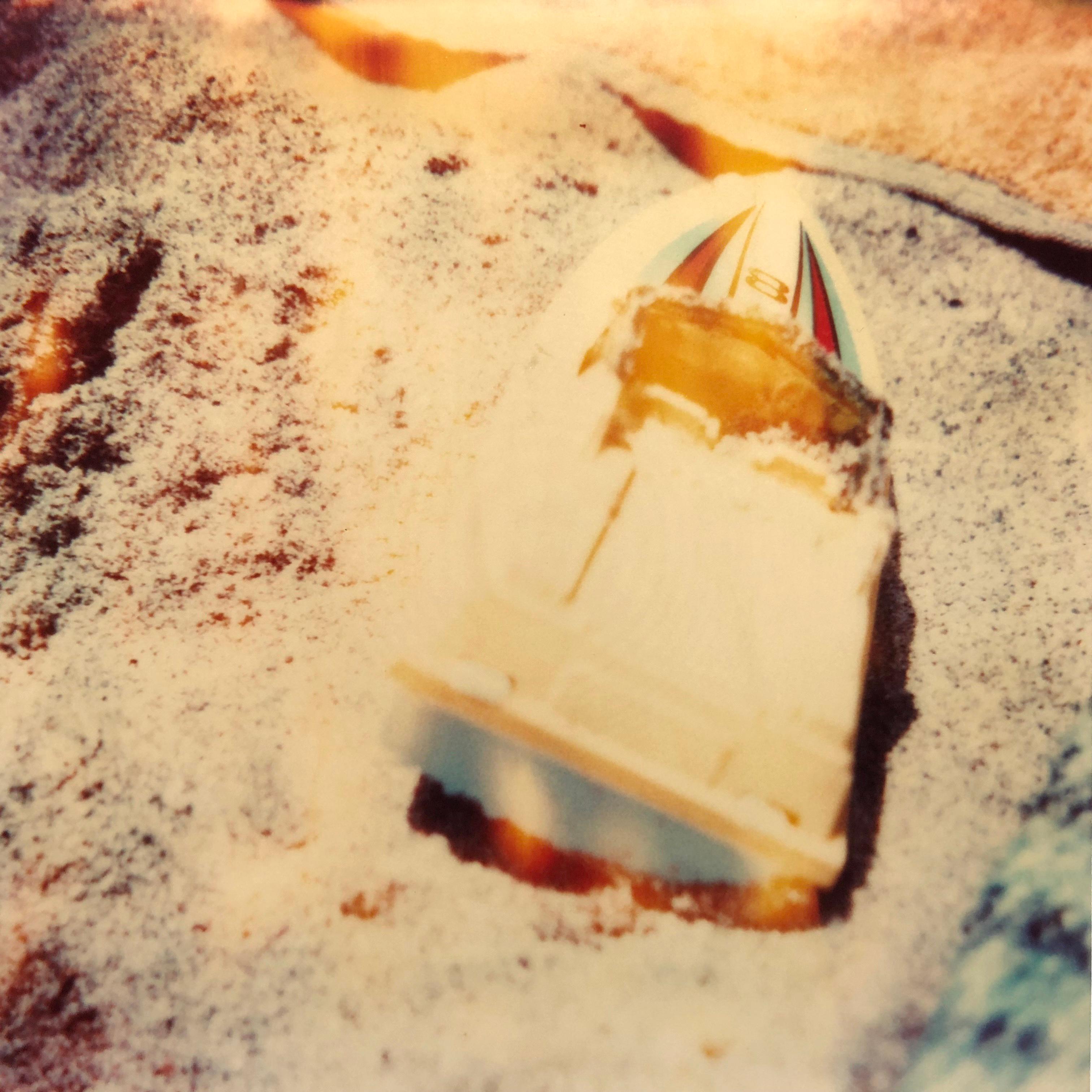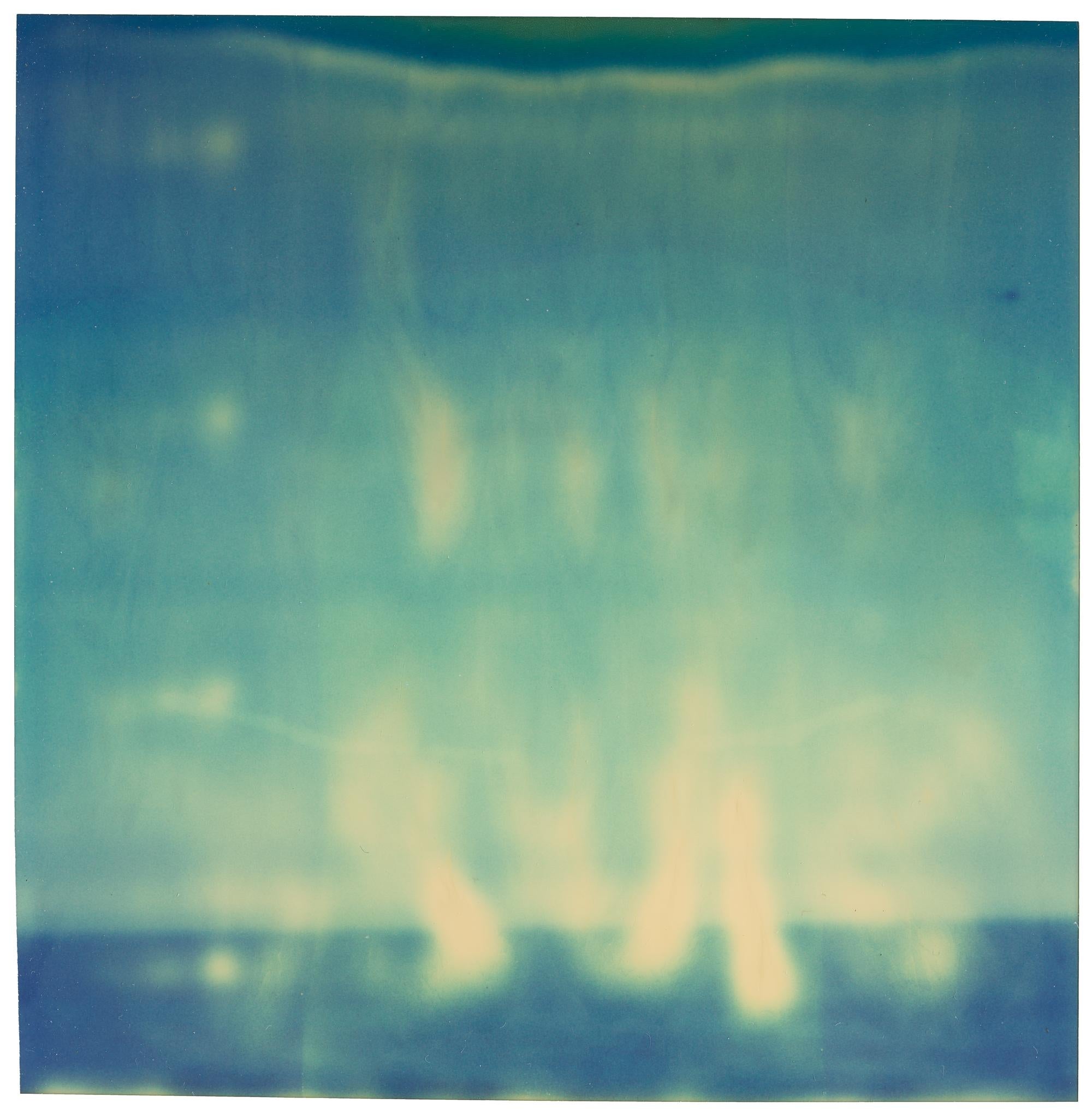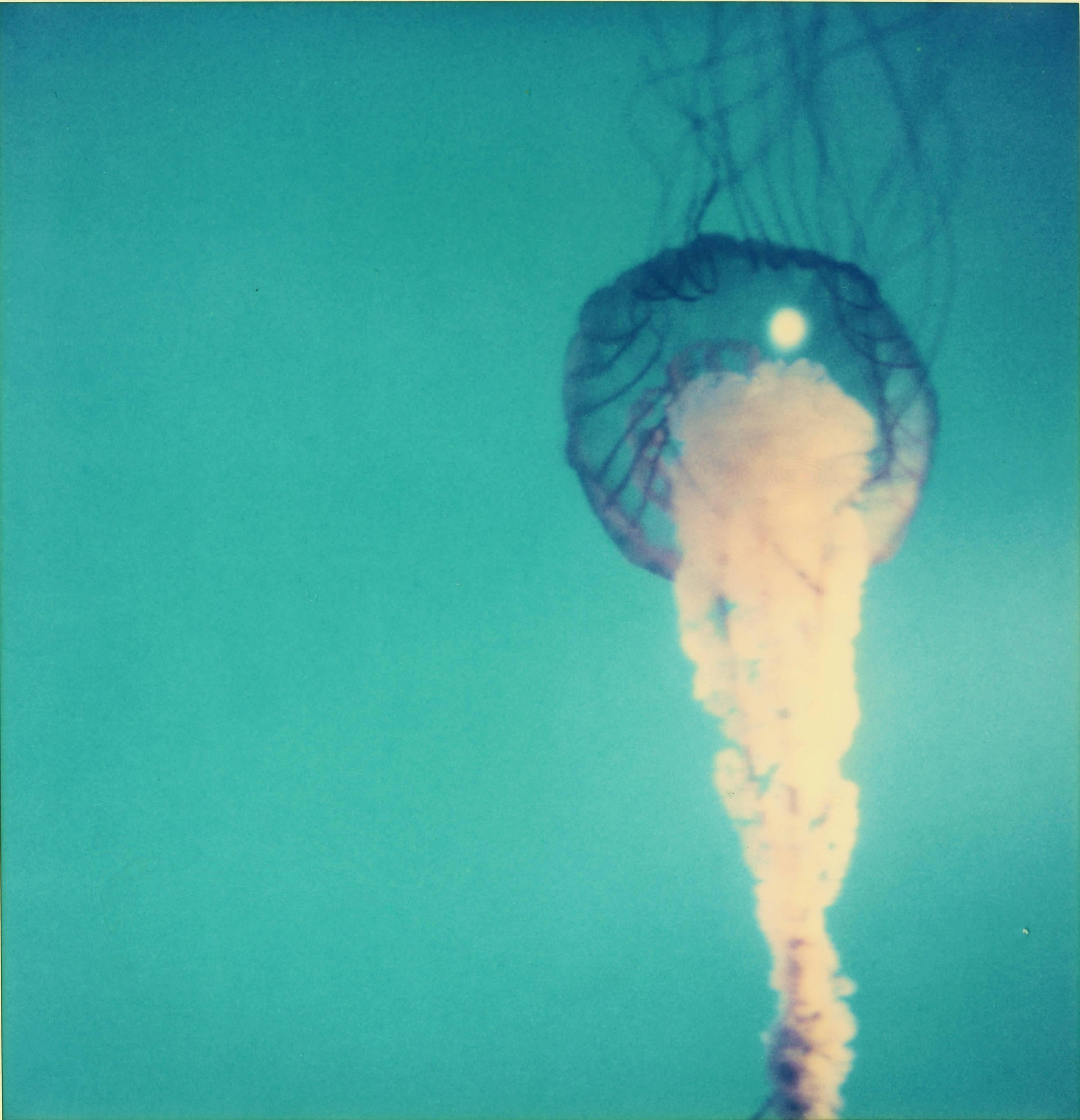Items Similar to Large Format Polaroid Photograph Color Photo David Levinthal Black Americana Art
Want more images or videos?
Request additional images or videos from the seller
1 of 15
David LevinthalLarge Format Polaroid Photograph Color Photo David Levinthal Black Americana Art1997
1997
About the Item
David Levinthal
Title: Untitled
Edition: 2/5
Hand signed, numbered and dated in ink on recto Date: 1997
Original Polaroid Large Format Print (Photo-Internal dye diffusion transfer)
Location: Cambridge Massachusetts United States
Dimensions: Image: 28 X 22 in. Framed: 36 X 30 inches
This depicts a still life of African American Blackface iron toys from his provocative, controversial photo series.
This body of work is drawn from David Levinthal’s project Blackface, dating from 1995-1998, it featured blackface Polaroids of his original memorabilia, drawn from the artist’s African American Americana personal collection, that are the Polaroid’s subject matter. Levinthal’s collection of black memorabilia evolved into Blackface, a stimulating and controversial body of work. The title, according to Levinthal, “makes reference to the many facades, poise and physicality of these figures.” The title is also taken from the name of a journal of a black film-making company and is a term referring to both blacks and whites. Traditionally associated with minstrel, these images were used to perpetuate negative stereotypes. Levinthal’s work was originally intended to be exhibited at Philadelphia’s ICA in 1997. However, the show was cancelled when it became a cause célèbre as a result of its controversial subject-matter. Subsequently, images from the series were exhibited at the International Center of Photography and at Janet Borden, Inc. in New York.
Levinthal’s initial inspiration for Blackface was D.W.Griffith’s 1915 film “Birth of a Nation,” a groundbreaking film of its time and a watershed moment in the cultural wars. It’s extreme and racist depictions of African Americans fueled a debate over the efficacy and motivation of using racially charged images that continues to reverberate in our culture today. Levinthal’s Blackface was originally intended to be a series based on “Birth of a Nation,” but the focus of the work shifted to the inscription of racially charged identities – what these collectibles convey, how they function within society, and how they continue to polarize social attitudes – within material objects produced and packaged as consumer goods.
Levinthal works using a 20 x 24 inch Polaroid Polacolor ER Land Film which results in a large format Polaroid. The objects are set against a black background, isolated and devoid of narrative. Investigating the images closely, the textures and surfaces of cracked paint, shiny plastic and rusty metal come into relief, creating a three-dimensional tactile surface expressing a melancholic humanism. The artist did little editing with these images, recording the object in its pure form. The majority of works exhibited are portraits of objects – sometimes human like and often exaggerated – both alluring and grotesque. Levinthal’s Blackface portraits unfold a repressed history associated with the black stereotype. The compositions are focused, the gloss seductive, and the light hitting their surfaces exquisitely mannered. The work is in constant tension between its controversial subject matter and its sensuality.Levinthal was born in 1949 in San Francisco, California. He received a Scientiæ Magister in Management Science from the MIT Sloan School of Management (1981), an MFA in Photography from Yale University (1973), and a BA in Studio Art from Stanford University (1970). He was the recipient of a Guggenheim Fellowship from the John Simon Guggenheim Memorial Foundation in 1995[2] and a fellowship from the National Endowment for the Arts in 1990–1991.
He has had retrospective exhibitions of his work at the International Center of Photography and the George Eastman Museum. Levinthal has produced a diverse oeuvre, utilizing primarily large-format Polaroid photography. His works touch upon many aspects of American culture, from Barbie to baseball to X-rated pornographic dolls. Levinthal's major series include Hitler Moves East (1972–1975), Modern Romance (1983–1985), Wild West (1986–1989), Desire (1991–1992), Blackface (1995–1998), Barbie (1997–1998), Baseball (1998–2004), and History (2010–2018).
His politically charged series, Blackface, consists of close-ups of black memorabilia, household objects infused with African-American stereotypes, and caused such a controversy that the Institute of Contemporary Art of Philadelphia was forced to cancel the exhibition while still in its early planning stages.
On his use of toys, Levinthal said that "Toys are intriguing, and I want to see what I can do with them. On a deeper level, they represent one way that society socializes its young. "Furthermore, Levinthal is aware of the power of toys: “Ever since I began working with toys, I have been intrigued with the idea that these seemingly benign objects could take on such incredible power and personality simply by the way they were photographed. I began to realize that by carefully selecting the depth of field and making it narrow, I could create a sense of movement and reality that was in fact not there.
- Creator:David Levinthal (1949, American)
- Creation Year:1997
- Dimensions:Height: 36 in (91.44 cm)Width: 30 in (76.2 cm)
- Medium:
- Movement & Style:
- Period:
- Condition:needs new frame. photo is well protected in frame.
- Gallery Location:Surfside, FL
- Reference Number:1stDibs: LU38211196282
About the Seller
4.9
Platinum Seller
These expertly vetted sellers are 1stDibs' most experienced sellers and are rated highest by our customers.
Established in 1995
1stDibs seller since 2014
1,560 sales on 1stDibs
Typical response time: 1 hour
- ShippingRetrieving quote...Ships From: Surfside, FL
- Return PolicyA return for this item may be initiated within 3 days of delivery.
More From This SellerView All
- Large Format Polaroid Photograph Still Life Color Photo Dye Print Betty Hahn ArtLocated in Surfside, FLVictor Schrager Title: Olympia Date: 1980 Original Polaroid Large Format Print (Photo-Internal dye diffusion transfer) Location: Cambridge Massachusett...Category
1980s Contemporary Color Photography
MaterialsColor, Polaroid
- Large Format Polaroid Photograph Still Life Color Photo Dye Print Robert FichterBy Robert FichterLocated in Surfside, FLRobert Fichter Title: Jonah Date: 1980 Original Polaroid Large Format Print (Photo-Internal dye diffusion transfer) Location: Cambridge Massachusetts United States Dimensions: Image: 27 1/2 x 20 1/2 in. (69.9 x 52.1 cm), Paper: 29 1/4 x 21 1/2 in. (74.3 x 54.6 cm) This depicts a large mouth fish with a toy soldier and Asian art (tattoo art?) in an abstract assemblage collage. From "Five Still Lifes" New York: Paradox Editions, Ltd., 1980. 5 original Polaroid color prints. Each hand signed, titled, dated and numbered 37/40 in ink in the margin. Each approximately 24 x 20in (image size). Each is on original as there are no negatives in this process. The photographers included: Robert Cumming, Robert Fichter, Betty Hahn, Victor Schrager...Category
1980s Contemporary Color Photography
MaterialsColor, Polaroid
- Large Format Polaroid Photograph Still Life Color Photo Dye Print Betty Hahn ArtBy Betty HahnLocated in Surfside, FLBetty Hahn Title: Belladonna Date: 1980 Original Polaroid Large Format Print (Photo-Internal dye diffusion transfer) Location: Cambridge Massachusetts United States Dimensions: Image: 27 1/2 x 20 1/2 in. (69.9 x 52.1 cm), Paper: 29 1/4 x 21 1/2 in. (74.3 x 54.6 cm) This depicts a still life of a flower with an old botanical drawing print plate. From "Five Still Lifes" New York: Paradox Editions, Ltd., 1980. 5 original Polaroid color prints. Each hand signed, titled, dated and numbered 37/40 in ink in the margin. Each approximately 24 x 20in (image size). Each is on original as there are no negatives in this process. The photographers included: Robert Cumming, Robert Fichter, Betty Hahn, Victor Schrager and William Wegman. The photos were produced in the Polaroid Corporation’s 20×24 studio in Cambridge, Massachusetts. This is an internal Dye Diffusion print (large format) Polaroid print. These are exceedingly rare now. This format was used by many of the leading photographers of the second half of the 20th century, among them Peter Beard, Chuck Close, David Levinthal, Robert Frank, David Hockney, Lucas Samaras, Andy Warhol, Robert Mapplethorpe and, perhaps most significantly, Ansel Adams More recently Ellen Carey has created large abstract masterpieces using this format. Betty Hahn (born 1940) is an American photographer known for working in alternative and early photographic processes. She completed both her BFA (1963) and MFA (1966) at Indiana University. Initially, Hahn worked in other two-dimensional art mediums before focusing on photography in graduate school. She is well-recognized due to her experimentation with experimental photographic methods which incorporate different forms of media. By transcending traditional concepts of photography, Hahn challenges the viewer not only to assess the content of the image, but also to contemplate the photographic object itself. Betty Hahn was born on October 11, 1940 in Chicago, Illinois where she also grew up. At the age of ten, Hahn was given her first camera by an aunt. Hahn later on went to graduate from Scecina Memorial Catholic High School. Soon after, she enrolled at Indiana University with a full scholarship where she furthered her studies in Fine Arts, receiving both her BFA (1963) and her MFA (1966). Throughout her undergraduate years, she concentrated in drawing and painting; however, as she entered graduate study, she worked in photography. During this important developmental period, Hahn studied under one of the most well-known photography teachers of the time, Henry Holmes Smith, who encouraged Hahn's work in alternative processes. Once she graduated, Hahn moved to Rochester where she taught at the Rochester Institute of Technology until 1975. Hahn then relocated to Albuquerque where she was professor at University of New Mexico until her retirement in 1997. Hahn is best known for her explorations of alternative processes in photography, using both older methods of darkroom developing such as gum-bichromate and cyanotypes, with other art mediums, including hand-painting and even embroidery. She is noted as one of the first photographers to successfully integrate such a variety of art mediums. Hahn encourages the viewer to think more deeply through not only the use of different physical processes in her artwork, but also through the multiplicity of meanings in her photographs. In most of her work, Hahn integrates humor and irony as she explores the meanings generated by formal combinations. Some of her prints include the sprocket holes of the 35mm negative, which allude to its 35mm film origins: but by hand coloring with bright paints, she draws attention to the mixture of craft with industrial mediums. Once she started experimenting with the gum-bichromate process, Hahn started stitching into her photographs. Printing onto canvas and other fabrics allowed her to use thread to highlight certain aspects of the photograph. In combining her photographs with conventional practices, Hahn successfully intertwines formal and conceptual aspects. Not only does she speak to the mundane tasks of everyday life, but also about routine and normativity. In highlighting the ordinary in her work, Hahn elevates and revives that which has been lost in the practice of daily life. Embroidery references femininity, as Hahn underlines the feminist issue of the anonymity of women's handicraft. Her embroidery often emphasized flowers with its three-dimensionality, furthering the idea of femininity; she later on pursued this as a symbol and incorporated it in several of her other series. In her work, Hahn delivers a powerful feminist message in regards to women and embroidery. It is quite evident through time that women's labor is needlework, and that their labor is frequently undervalued as craft both when dissimilar and alike to men's work. In a time period where men overshadowed women in the traditional art, such as painting and sculpture, women oftentimes reverted to other mediums like textiles. It has been suggested that women's work, especially in embroidery, is of little value in the art field since it is considered a craft. Since "arts and crafts" are more often than not paired together, it is obvious they are in the same category; however, there is a clear distinction. For 300 years, women have been taught needlework through practice and tradition, and in inadvertently, promoted obedience and household effeminate behavior. As a result, instead of regarding stitching as an art, many viewed it as a thoughtless skill, lacking originality. On the contrary, however, it is far more than evident that the hand of woman is more than a mindless and conforming thing, it is one of sensitivity, thought, patience, perseverance, and strength. By incorporating embroidery and stitching, Betty Hahn pushes the audience to acknowledge the work of women not as craft or tradition, but as meticulous, creative and unique. Exhibitions The Division of Photographic History at the Smithsonian Institution exhibited Hahn's work in a group exhibit in the 1960s as a part of a developing series of displaying the works of women photographers. Afterwards her work was featured in multiple thematic exhibitions at the Smithsonian. Hahn's first solo show exhibiting her work was in 1973 at the Witkin Gallery in New York City. Thereafter, she received several grants from the National Endowment for the Arts in 1974, 1978, and 1983 to continue her work in explorative photography. Hahn's art has been exhibited throughout the country and worldwide featured in museums highlighting historical processes in Baltimore, Maryland (1972) and nature photography exhibitions in Osaka, Japan (1990). Her work has been displayed at the Albuquerque Museum of Art and Art History (2017), Phoenix Art Museum (2015), and the George Eastman House (2012, 2016). Hahn's work is held in private collectors, galleries, and in permanent museum collections, including the San Francisco Museum of Modern Art, Center for Creative Photography and the Museum of Modern Art. Exhibitions 1996 – George Eastman House International Museum of Photography and film, Rochester, New York 1997 – A History of Women Photographers, Akron Art Museum 1997 – Eye of the Beholder, Photographs of the Avon Collection, International Center of Photography, Midtown, New York City 1998 – Passing Shots: A Travel Series, University of New Mexico Art Museum, Albuquerque, New Mexico 1998 – The City Series, Taos, Albuquerque, Santa Fe, Cedar Rapids Museum of Art, Cedar Rapids, IA 1999 – Photography Or Maybe Not, a Betty Hahn traveling retrospective, Mikhailovsky Palace, St. Petersburg, Russia 2000 – 20/20 Twentieth Century Photographic Acquisitions by 20 leading patrons, Museum of New Mexico, Museum of Fine Arts 2000 – Photography Or Maybe Not, a Betty Hahn traveling retrospective, Santa Fe de Granada, Spain 2001 – In the Eyes of the Beholder: Ten Photographers View Albuquerque, The University of New Mexico Hospital, Albuquerque, NM 2002 – Sun Works Contemporary Alternative Photography, The Art Institute of Boston 2002 – Flowers from the Permanent Collection, The Albuquerque Museum, Albuquerque, New Mexico 2004 – 30th Anniversary Permanent Collection Exhibition, New Mexico State, University Art Gallery, Las Cruces, New Mexico 2005 – New Mexico State University Art Gallery, Las Cruces, New Mexico 2005 – Ace in the Hole, the legacy of Peter Walch, University Art Museum, University of New Mexico, Albuquerque, NM 2006 – The collectible moment, Norton Simon museum, Pasadena, California 2006 – The Social Lens, University of Virginia Art Museum, Charlottesville, Virginia 2007 – Seeing Ourselves: Masterpieces of American Photography, A Traveling 2007 – Exhibition, George Eastman House, Rochester, New York 2008 – Flower Power: a Subversive Botanical, New Mexico Museum of Art, Santa Fe, NM 2008 – Bernalillo County Arts Board Gallery, One Civic Plaza NW, Albuquerque, NM 2008 – Giving Shelter 516 Arts Albuquerque, NM (A Sister Exhibition to the Cradle Project) 2008 – Betty Hahn, Joyce Neimanas, and Judith Golden, Harwood Art Center Albuquerque, NM 2009 – Through the Lens: Creating Santa Fe, Palace of the Governors, The New Mexico History Museum, Santa Fe, 2009 – Altered Land: Photography in the 1970s, Sheldon Museum of Art, University of Nebraska, Lincoln, Nebraska 2010 – Sole Mates Cowboy Boots & Art, New Mexico Museum of Art 2010 – Rock Scissors Paper, Anderson Contemporary Arts, Albuquerque, NM 2010 – Recollection 2010, Works from the Colorado Photographic Arts Center, The Central Library, Vida Ellison Gallery, 2012 – 60 From the 60's (an exhibit of influential photos from the 1960s) George Eastman House, Rochester, New York 2012 – Albuquerque Now-Fall and Albuquerque Now-Winter, The Albuquerque Museum of Art and History, 2013 – It's About Time: 14,000 Years of Art in New Mexico, The New Mexico Museum of Art, Albuquerque, NM 2014 – Alternative Lineage – Honoring Betty Hahn; 5 Decades of Mentoring 2014 – Alternative Photographic Processes, Center for Photographic Art Carmel, California 2014 – Alternative Lineage, Northlight Gallery, Arizona State University, Tempe, Arizona 2014 – Transformational Imagemaking, Handmade Photography Since 1960 2014 – An Exhibition Curated by Robert Hirsch, CEPA Gallery, Buffalo, NY 2014 – Museum Project, dnj Gallery, Santa Monica, California 2014 – American Heritage Center and Art Museum, University of Wyoming, Laramie, Wyoming 2014 – Hubbard Museum of the American West, Ruidoso, New Mexico 2015 - One-Of-A-Kind, unique photographic objects from the Center of Creative Photography, University of Arizona, 2015 – Unconfined – Empowering Women Through Art, African American Performing Arts Center, New Mexico Expo, 2015 – Visualizing Albuquerque: Art of Central New Mexico, Albuquerque Museum, Albuquerque, NM 2015 – Healing ... For the Time Being, A mixed media exhibition in conjunction with On the Map: Albuquerque Art and Design, Jonathan Abrams MD 2015 – The AIPAD Photography Show, Represented by Joseph Bellows Gallery, New York, New York 2016 – Transformational Imagemaking, traveling exhibition March-16- April 16; Muhlenberg College, Allentown, Pa. 2016 – Fall-Rochester Institute of Technology, Bevier Gallery, Rochester, NY 2016 – 60 from the 60's: Selections from the George Eastman Museum, At the Hyde Collection, Glens Falls, New York (The featured artists included were Harry Callahan, Benedict J. Fernandez, Hollis Frampton...Category
1980s Contemporary Color Photography
MaterialsColor, Polaroid
- Large Cibachrome Color Photograph LA Woman Artist Dress, Feminist, Photo C PrintLocated in Surfside, FLA large scale Cibachrome photograph. An abstract work from the series titled, "Fairfax Ladies," (the historic old Jewish neighborhood of Los Angeles) produced 1983. The subject was created through by placing diaphanous fashion garments onto photo-sensitive paper, embellishing them with objects, paper bits, and flora, and layering in painterly surfaces with scratches, completely covering the image. The series won a prize in the BCibachrome competition (1985), sponsored by BC Space Gallery (Laguna Beach, CA), and was exhibited at "Robin Valle: From Darkroom to Digital, Works from 1974-2009," posthumously presented August 2009 at El Camino College Gallery (Torrance, CA). Work presented under plexiglass in a custom wood frame. Work Size: 39.5 x 29.5 in. Framed Dimensions: 43.5 X 33.5 X 2 in. Valle, Robin Joy (1953-2009) After receiving her BA from SMU and an MFA in Photo/Cinematography from the University of Illinois in 1977, she moved to Los Angeles. Valle exhibited her one-of-a-kind Cibachrome photographs at galleries and museums locally and nationally. In 1982, she was selected for the NEA funded, "Life in LA" project, sponsored by the Los Angeles Women's Building. Valle taught photography at many Southland colleges as well as the LA County High School for the Arts. She was one of the first LA based photographers to explore digital media, receiving an Innovative Instruction Grant from Chaffee College in 1989 to create their first photography class in digital media. In 1998 she became a member of the full-time faculty at El Camino College, where she was instrumental in developing the Digital Arts program. Her work ranged from Black and white photographs to colorful, intricately layered patterns that command the gallery walls. It isn’t surprising that she, along with fellow art instructor, Joyce Dalal, contributed largely to the ECC art department’s merge towards digital art. As one of the first local photographers to explore digital media, she was crucial to the development of the Digital Arts Program. Before computers became commonplace, Valle’s techniques show a digital influence. “Her work was always inventive”, said ECC art curator, Susanna Meiers. An effect that can easily be done now with a few mouse clicks on Adobe Photoshop, required a long process of rubbing dye into the actual photograph in the ’70s. Her methods of illustrating were just as unique as the topics themselves. Photographs of the violent Chinese protest at Tiananmen Square in 1989 where military response murdered protestors in large numbers included photographing images from her television screen. “Crime Stats/ Hollywood” was a theme she dedicated to the gang violence around her neighborhood in the early ’90s. With washed out gang members as the focal point, and graffiti as well as mapped out grids of Los Angeles as the backdrop, Valle’s layering, collage-like technique is continued on and more developed. “There is a fanciful, imaginary quality of her work,” said Meiers. From her quirky pieces of birds, zebras, and even dinosaurs enveloped in patterned, colorful, designs to her more serious themed feminist pieces, her eclectic, colorful style breaks through. Her feminism is on display in “Expectations” which illustrates women’s ability to “look good and produce children.” A bright human embryo steals your attention dead center, with a “June Cleaver” type 1950’s woman smirking at you from either side of it. A mustard yellow backdrop, brings the entire piece together illustrating society’s views of women as well as her playfulness as an artist. “Robin was terribly funny and had a laugh that would just set people off,” Meiers said. The art curator designed a section of the gallery similar to Valle’s apartment. A bright pink shelf...Category
1980s Contemporary Still-life Photography
MaterialsC Print
- Pop Art Color Photograph Dye Transfer Print Audrey Flack Tarot Card, Skull PhotoBy Audrey FlackLocated in Surfside, FLHand signed and titled in ink by the artist from edition of 50 (plus proofs). Color Photo printed at CVI Lab by master printer Guy Stricherz. Published by Prestige Art Ltd. From the ...Category
1980s Photorealist Color Photography
MaterialsPhotographic Paper, C Print, Dye Transfer
- Pop Art Color Photograph Dye Transfer Print Audrey Flack "Skull & Roses" PhotoBy Audrey FlackLocated in Surfside, FLHand signed and titled in ink by the artist from edition of 50 (plus proofs). Color Photo printed at CVI Lab by master printer Guy Stricherz. Published by Prestige Art Ltd. From the ...Category
1980s Photorealist Color Photography
MaterialsPhotographic Paper, C Print, Dye Transfer
You May Also Like
- Room No. 503 - Strange Love, analogBy Stefanie SchneiderLocated in Morongo Valley, CA'Room No. 503' (Strange Love) - 2010 128x125cm, Edition of 5, analog C-Print printed on Fuji Archive Paper, hand-printed by the artist based on the Polaroid, signature label and ...Category
2010s Contemporary Color Photography
MaterialsArchival Paper, Photographic Paper, C Print, Color, Polaroid
- Winchester (Wastelands) - Contemporary, 21st Century, Polaroid, FigurativeBy Stefanie SchneiderLocated in Morongo Valley, CAWinchester (Wastelands) - 2003 Edition of 5, 57x56cm, Analog C-Print, hand-printed and enlarged by the artist on Fuji Crystal Archive Paper, based on the Polaroid, certificate and signature label, Artist inventory Number 1237.04, Not mounted. Reality with the Tequila: Stefanie Schneider’s Fertile Wasteland by James Scarborough “How much more than enough for you for I for both of us darling?” (E. E. Cummings) Until he met her, his destiny was his own. Petty and inconsequential but still his own. He was cocksure and free, young and unaccountable, with dark hair and aquiline features. His expression was always pensive, a little troubled, but not of a maniacal sort. He was more bored than anything else. With a heart capable of violence. Until she met him, she was pretty but unappreciated. Her soul had regis- tered no seismic activity. Dust bowl weary, she’d yet to see better days. A languorous body, a sweet face with eyes that could be kind if so inclined. Until she met him, she had not been inclined. It began when he met her. She was struck in an instant by his ennui. The sum of their meeting was greater than the imbroglios and chicaneries of their respective existences. He was struck by the blank slate look in her eyes. They walked, detached and focused on the immediate, obscenely unaware of pending change across a terrain of mountainous desert, their eyes downcast and world-weary, unable to account for the buoyant feeling in her heart. His hard-guy shtick went from potentiality to ruse. The gun was not a weapon but a prop, a way to pass time. Neither saw the dark clouds massing on the horizon. They found themselves alone in the expanses of time, unaware of the calamity that percolated even as they posed like school kids for the pic- tures. Happiness brimmed in that wild terrain. Maybe things were begin- ning to look up. That’s when the shooting started… Stefanie Schneider assumes that our experience of lived reality (buying groceries, having a relationship with someone, driving a car) does not correspond to the actual nature of lived reality itself, that what we think of as reality is more like a margarita without the tequila. Stefanie Schneider’s reality is reality with the tequila. She does not abol- ish concepts that orient us, cause and effect, time, plot, and story line, she just plays with them. She invites us to play with them, too. She offers us a hybrid reality, more amorphous than that with a conventional subject, verb, and predicate. Open-ended, this hybrid reality does not resolve itself. It frustrates anyone with pedestrian expectations but once we inebriate those expectations away, her work exhilarates us and even the hangover is good. An exploration of how she undermines our expectation of what we assume to be our lived reality, the reasons why she under- mines our expectations, and the end-result, as posited in this book, will show how she bursts open our apparatus of perception and acknowl- edges life’s fluidity, its density, its complexity. Its beauty. She undermines expectations of our experience of reality with odd, other- worldly images and with startling and unexpected compressions and expansions of time and narrative sequence. The landscape seems familiar enough, scenes from the Old West: broad panoramic vistas with rolling hills dotted with trees and chaparral, dusty prairies with trees and shrubs and craggy rocks, close-up shots of trees. But they’re not familiar. These mis-en-scenes radiate an unsettling Picasso Blue Period...Category
Early 2000s Contemporary Color Photography
MaterialsArchival Paper, Photographic Paper, C Print, Color, Polaroid
- Mindscreen 8 - Contemporary, 21st Century, Polaroid, Figurative, ColorBy Stefanie SchneiderLocated in Morongo Valley, CAMindscreen 8 - 1999 58x56cm, Edition of 10. Analog C-Print, hand-printed by the artist, based on the Polaroid. Not mounted. Signed on back with Certificate. Artist Inventory No. 2...Category
1990s Contemporary Color Photography
MaterialsPhotographic Paper, Archival Paper, Polaroid, Color, C Print
- Toy Boat (Malibu) - mountedBy Stefanie SchneiderLocated in Morongo Valley, CAToy Boat (Malibu) - 2004 Edition 1/5, 39x37cm. Analog C-Print, hand-printed by the artist, based on the Polaroid. Artist inventory Number 662.01. Mounted...Category
Early 2000s Contemporary Still-life Photography
MaterialsMetal
- Horizon (Malibu)By Stefanie SchneiderLocated in Morongo Valley, CAHorizon (Zuma Beach) - 1999 48x47cm, Edition of 10, plus 2 Artist Proofs. Archival C-Print, based on the Polaroid. Certificate and Signature label. Artist Inventory #20431. Not...Category
Early 2000s Contemporary Still-life Photography
MaterialsMetal
- Jelly Fish from the movie Stay based on a PolaroidBy Stefanie SchneiderLocated in Morongo Valley, CAStefanie created the art for both main actors Naomi Watts and Ryan Gosling in the movie 'Stay' directed by Marc Forster. She also created the art for several dream sequences and the end credit sequence for the movie. 'Jelly Fish'' (Stay) - 2006 50x48cm, Edition of 10 plus 2 Artist Proofs. Archival C-Print, based on the original Polaroid. Signature label and certificate, Artist Inventory Number 5492. Not mounted. ------------------------------------------------ Stefanie Schneider: A German view of the American West The works of Stefanie Schneider evoke Ed Ruscha's obsession with the American experience, the richness of Georgia O'Keefe's deserts and the loneliness of Edward Hopper's haunting paintings. So how exactly did this German photographer become one of the most important artists of the American narrative of the 20th and 21st century? Schneider's ability to control, or at least predict, the outcome of a pack of Polaroid film is a testament to her experience and intuitive understanding of the medium. With years of practice and countless rolls of film, she has honed her skills, shooting from the hip and grounding her decisions in her gut instincts. It's a symbiotic dance, where she juggles the film, the actors, and the set simultaneously. Every aspect of a Stefanie Schneider photo...Category
Early 2000s Contemporary Color Photography
MaterialsArchival Paper, Photographic Paper, C Print, Color, Polaroid
Recently Viewed
View AllMore Ways To Browse
Vintage Black Color
Large Vintage Photo
Large Color Field
Shiny Art
Vintage Colour Background
Narrow Art
X Rated
Art Against War
Make Art Not War
Americana Sign
Americana Photography Art
Black Americana
Photography Vintage Objects
Black Americana Art
Vintage Polaroid Photographs
Provocative Art Photography
5 X 5 Inch Photo Frames
Vintage Americana

